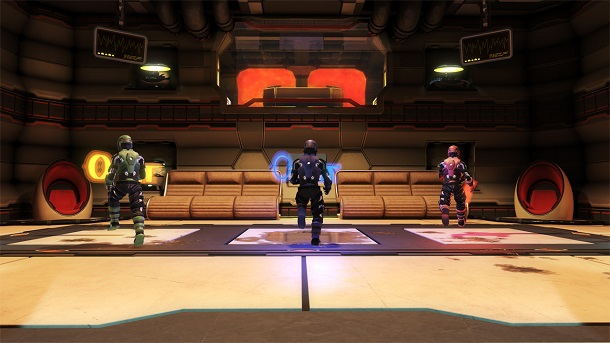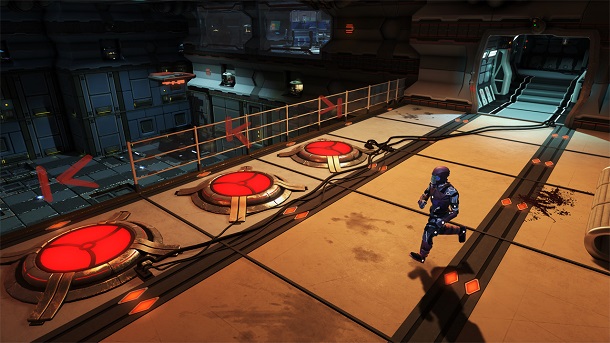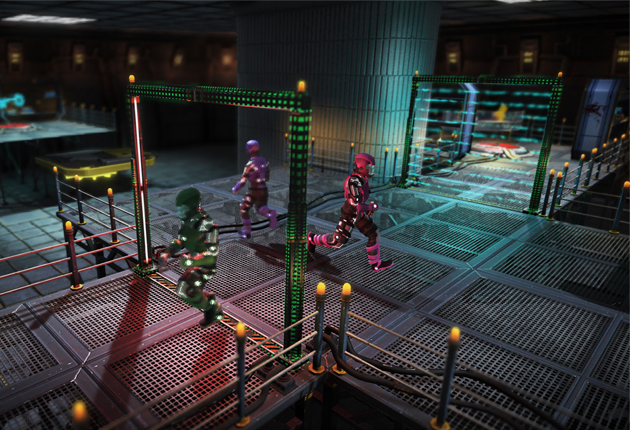It’s really, really hard to find a new and inventive puzzle game these days. In the years following the success Portal, we’ve seen countless games taking heavy influence from Valve’s surprise entry in the genre, but that’s not necessarily a bad thing, so long as there’s a new spin to it, right? =
Project Temporality throws you into the shoes of an unnamed test subject who’s recently been the recipient of a fancy new brain implant that begets the user time manipulation and on-the-fly cloning abilities and have been let loose in a test facility. I know, I know, it makes zero narrative sense, but it makes for some decent puzzling.
 The story setup and environment are Portal-esque, for sure, and the test facility is eerily similar to every random office and research building in Mass Effect 2, complete with a giant, glowing sun shining in through every window a la the Illusive Man’s hideout. I can’t really hold any of that against it, though, as good stories in a puzzle game are few and far between, and it doesn’t look bad by any stretch of the imagination, it just doesn’t look very good, either. It has that definite air of being an indie’s first foray into creating a 3D world with their own engine, which is a respectable effort, even if it doesn’t look particularly great.
The story setup and environment are Portal-esque, for sure, and the test facility is eerily similar to every random office and research building in Mass Effect 2, complete with a giant, glowing sun shining in through every window a la the Illusive Man’s hideout. I can’t really hold any of that against it, though, as good stories in a puzzle game are few and far between, and it doesn’t look bad by any stretch of the imagination, it just doesn’t look very good, either. It has that definite air of being an indie’s first foray into creating a 3D world with their own engine, which is a respectable effort, even if it doesn’t look particularly great.
Most 3D puzzlers have a general gimmick or conceit that all puzzles are based around, Portal had it’s portal gun and Antechamber had you rethink all your concepts of spatial reasoning. Project Temporality’s conceit is time travel with a cloning element.
The time manipulation aspect of the game is simple as are at times, consisting solely of rewinding your progress to any point in the level and turning back the clock used to rate your performance upon completion. During these moments of freezing and rewinding time, however, is when you gain the ability to drop in clones and split your timelines as a means of puzzle solving.
While manipulating time, you’re able to drop in clones at any time. Once a clone is dropped, you split from your original timeline and control the clone while your other self continues to carry out any and all actions that done prior to turning back the clock. This becomes the game’s main gameplay conceit, and is used to solve all of the puzzles across the game’s 14 levels.
While you’re able to introduce up to 11 clones into the mix, I never really found myself needing more than five or six to complete the lion’s share of the game’s puzzles, as the puzzle solving basically boils down to figuring out the proper sequence and timing to hit switches to open doors and trigger platforms to get from point to point.
 Occasionally the game will throw “temporality fielded” puzzles at you, which introduce an element of permanence to your actions that you can’t just infinitely rewind and replay, and must instead get it done properly in one go or reset to a checkpoint. These puzzles help break up the monotony of the basic puzzle types, and give an extra element of difficulty to help keep things fresh, as they’re added sparingly and don’t really wear out their welcome.
Occasionally the game will throw “temporality fielded” puzzles at you, which introduce an element of permanence to your actions that you can’t just infinitely rewind and replay, and must instead get it done properly in one go or reset to a checkpoint. These puzzles help break up the monotony of the basic puzzle types, and give an extra element of difficulty to help keep things fresh, as they’re added sparingly and don’t really wear out their welcome.
Recent games like Dark Souls have gotten me used to not having a traditional level of hand-holding and instruction, which makes sense for games of that type. However, there isn’t really a good excuse for not explaining the better part of important game mechanics until after you banged your head against a wall long enough to brute force a puzzle, especially when the puzzles themselves are designed to be pretty difficult at times. I found that it only managed to add an extra layer of abstraction, rather than provide a satisfying challenge, and only really helped to add to my frustration.
While on the subject of frustration, occasionally I found myself faced with puzzle solutions that required a great deal of fast and precise platforming. In most games this wouldn’t be much of an issue, but the player movement is sluggish and the jump is really floaty, which had me falling to my death more often that I was met with success.
All in all, Project Temporality isn’t really going to set the world on fire, and while the concept isn’t particularly unique, it does have a nice variety of puzzles to help you kill a couple of hours here and there, and really, for $15, I’m just fine with that.
This review is based on a Steam code sent to SideQuesting by the publisher.



No Comments